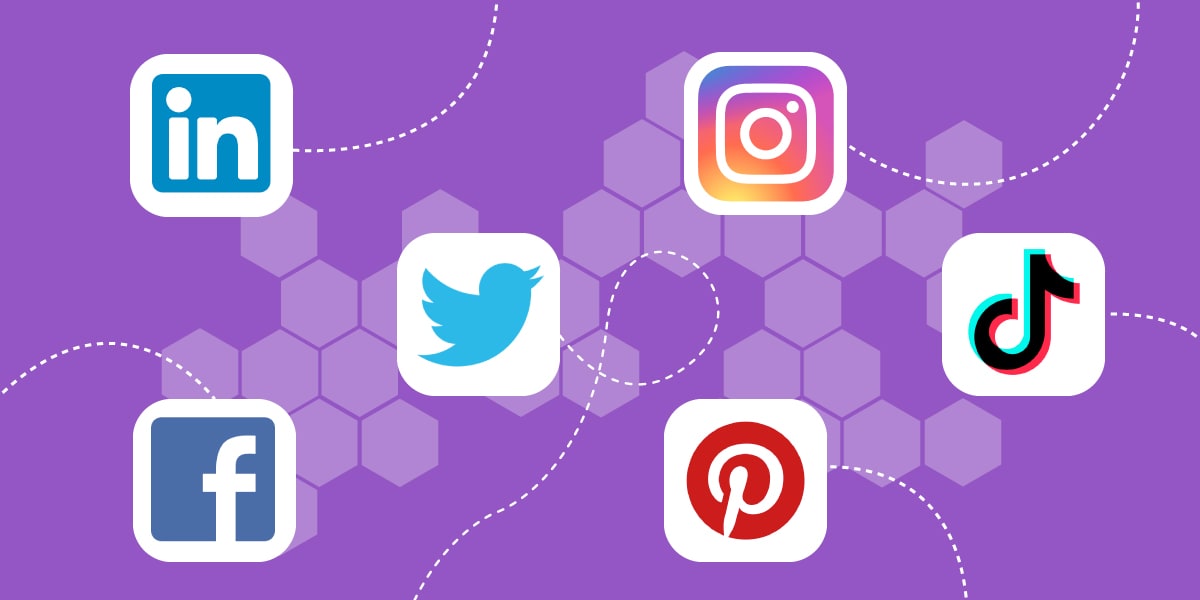10 Social Media Marketing Tips for Small Businesses to Boost Engagement
Anyone can tweet something or pin something, but to truly get the most out of your social media channels, you will want to put in the effort. Using social media can help to increase your brand awareness, engage with your followers and increase traffic back to your business website.
Finding where your audience is, optimizing your messaging, diversifying your content, and posting on a regular schedule are just a few tips on social marketing that can help maximize your time and effort on social channels like Facebook, Pinterest, LinkedIn and Twitter.

If you’re trying to improve your social media strategy, read on, as I’ve got 10 top tips to help you make the most out of your time and effort.
- Find your target audience
- Use the right social media platforms
- Optimize your bios, descriptions & profiles
- Diversify the content you share & promote
- Post on a schedule – find the right time for your audience
- Cross promote – try and get email list sign ups
- Interact and engage with your followers
- Be current and stay ups to date with trends
- Save time with the tools
- Analyze your social media campaigns to improve
1. Find your target audience & research the competition
Thinking you know which platforms to target and networks based on your gut instinct is not the right way to go.
It would be best if you took the time to do your research to find out where your prospective followers are hanging out. Deep dive into research from some social media stats to figure out what age groups use which channels best, how long they spend on them, and what they’re sharing the most.
Finding out who your competition is is a good place to begin if you’re just starting.
Figure out what keywords they are using, check who ranks on search engines, and when you search for those keywords on social media platforms. Find out what content those companies focus on, and you’ll get a good idea of who they are targeting and the type of content they are creating.
You can also find out the best tone to use depending on the platform and find ways to improve on what they are doing.
If you already have a platform, perform a social media audit to find out which type of content gets the most shares, how your followers engage with it, and how your brand is portrayed. That’ll help identify key points of your strategy that you can improve upon.
Finding where your audience is, doing social media competitor analysis, and a social media audit are good first steps in laying the foundations for a stable and successful strategy.
2. Use the right social media platforms
Once you’ve identified the best social media competitors and where your audience is, it’s time to figure out how many resources you have to create a decent presence on them and keep up with your competition.
If you’re a business owner without a dedicated social media manager, you’re going to want to pick one or two key platforms to focus your efforts.
Spreading yourself too thin across lots of different channels will diminish your ability to:
- Create enough compelling content
- Engage with your customers efficiently
- Could have a negative effect on your brand
Suppose you have a dedicated manager who takes care of your social media or a team. In that case, you have the resources to create lots of great content or branch out into other channels to help maximize your exposure without negatively affecting your brand or business.
Time constraints and resource limits are why it’s important to do your initial research. Find the right social media platforms to focus on first and then expand over time as you get the traction, money, and resources to do so.

3. Optimize your bios, descriptions & profiles
After you’ve picked the social media networks you’re going to focus on, you’ll need to make your profile as engaging as possible.
Write in a tone that fits your audience for the network you’re on, and be truthful and relatable. Optimize your descriptions, bios, and profiles for searchable keywords without stuffing them, making it look and sound like you’re just another spammer.
Keep it simple and explain what you offer, how you can help them, and what they’ll get back from following you.
Here’s a few tips on how to optimize your social media profiles:
- Add links to your website where possible
- Use appropriate hashtags
- Use a quality profile picture and background that showcases your brand
- Make your brand or business name clear
Do these, and you’ll have a good basis from which to start tweeting, sharing, pinning, and uploading content.
4. Diversify the content you share / promote
Step 4 is about creating content for social media that is shareable, likable, or watchable.
Depending on the platform(s) you use will determine how much this applies to you and the type of content you’re able to create.
However, if you usually create images, try adding videos. If you typically link back to your content, try posting about something helpful that’s on topic but not self-promoting.
Optimize the type of content you create for each platform to help it stand out better and engage more with your prospective customers.
Changing up your content strategy for social media can help your brand resonate with a larger audience.
It’s worth experimenting and analyzing the statistics, and you might just find what you thought was working works only half as good as something else.
5. Post on a schedule / right time for your audience
Another way to reach out to more people is to set up a posting schedule that maximizes your audience’s chance of seeing your posts.
If you’ve researched your audience, you’ll have found stats about the times and days at which people are more likely to spend their time browsing through their social media channels.
Not every channel’s timing is the same, so you have an excellent opportunity to continually get your content seen throughout peak times. Especially if your audience is worldwide, setting up multiple posts to go at different times of the day will have a higher chance of it being seen by your followers and prospective new followers across the globe.
Day of the week counts, too, by the way.
If this sounds too time-consuming, there are a few ways in which you can get help. One of those is using some of the best social media management tools. Some of these have built-in scheduling tools that provide you with the best times to schedule based on the specific platform.
6. Cross promote – try and get email list sign ups
You’ve been working hard to maximize your brand awareness and increase your followers. It’s time to start cross-promoting your social media traffic and start building an email list.
Email marketing is a powerful tool in any online marketer’s toolbox. It gives you a direct line to potential customers interested in what you are selling or promoting.
With people more likely to purchase from a brand they already know or have bought from in the past, growing your email list is vital in diversifying your revenue potential. It helps mitigate against any third party tool changing its terms and conditions or going out of business.
Taking your social media followers and being able to add them to a source that you can control provides you with many benefits:
- You’ll be able to promote your latest products and posts
- Run polls and gather more information on your readers
- Add another way to increase your brand awareness
- Take away reliability on third party software
- Protect your business against search engine algorithm changes
Now and then, be sure to try and get your followers to sign up for your email list, and it might have a significant impact on your conversions.
7. Interact and engage with your followers
Social media is a great way to interact with your customers and can be used as another help support desk. You can keep them updated on your opening hours and services and answer any problems individuals might be having.
Interacting and engaging with your followers can also be a great way to gather feedback about your business, website, or brand.
Setting up polls, and questionnaires, running competitions, and having conversations with your followers can help you identify key areas or problems that they might be having. You’ll be able to find ways to improve what you offer and try to keep your customers happy at the same time.
Building relationships with your followers can help with conversions too. Over time you can build more trust in your brand, leading to more conversions. A satisfied customer is more likely to want to return to your business time and time again than an unhappy one.
You can build relationships in many different ways including:
- Creating groups and participating in communities
- Mentioning your followers in your posts
- Offering discounts and rewards
- Share, like and comment on your followers posts
Whichever way you interact with your social media followers, stay true to your brand and be helpful.
8. Be current and stay up to date with trends
To get a leg up on the competition and help grow your follower base across social media networks, it can help if you keep up to date with current topics and trends.
Share and post information about current world events, sports, celebrities, or what’s relevant to your industry to increase your potential for your posts to be seen and shared.
Pick wisely, and jumping on trends in social media could help you reach a world of potential new customers.
People are always looking to keep up to date with the latest news and events, so if you can create funny, engaging content around these, you could see your social accounts profit from it.
Not only that, but it helps to use the most popular social media channels for the times. Facebook and Twitter used to be the place to be, but since its release, TikTok has taken the world by storm with its different way of consuming media.
9. Save time with the tools
There’s no denying that when running a small business, not having enough time to do things is a major pain point for many. We want to be able to do more in a shorter period to keep up with our competitors and boost our overall business stats.
You can save time managing social media accounts through social media management tools like MeetEdgar, SproutSocial, and Hootsuite.
These types of business tools bring all of your social media accounts into one easy-to-use platform where you’ll be able to create, schedule, and analyze your posts across different channels.
Drag and drop style calendars let you quickly see an overview of your social media campaigns across all platforms while allowing you to create and edit specific posts if needed.
Many have built-in social media inboxes where you’ll be able to read and respond directly to your followers from within your account, saving time switching between browser tabs or apps and making sure you never miss an opportunity.
You can also keep track of what people are mentioning about your brand, letting you get an overall consensus of your brand’s popularity and try to fight fires against any negative brand mentions proactively.
The best social media planning tools have been built to help all types of marketers, whether that’s the do it all Daisy, the general website marketer Mike, or social media manager, Stacy, to help individuals and teams get the most out of their social strategies.
Top Social Media Tools
- Unlimited scheduled posts across your linked social accounts
- Create a library of evergreen posts & get Edgar to automatically schedule when you run out
- Monitor and A/B test your posts to see what does and doesn't work
- Save time planning and publishing, use the composer to add posts no matter the platform
- View scheduled content with details of each post and advert details available with a click
- Monitor organic and paid ad campaigns across social channels
View DealsHootsuite Review 2025: A Top Social Media Management Tool? Features
- Find social media post ideas with the content curation platform and discover trending content to post
- Save time through automations, repeat posting, and creating drafts for approval
- Schedule posts across Facebook, Twitter, Instagram, LinkedIn, Pinterest and more
View DealsSocialPilot Review (2025): Features, Pricing & Why It’s Great for Social Media Management Features
10. Analyze your social media campaigns to improve performance
Once you’ve managed to find your audience, optimize your content, engage with your audience, and have taken the time to learn the social media tools, it’s time to analyze the performance of your posts.
For small companies, analysis is one area that is often overlooked but can be vital to finding areas in which only a slight improvement could see a significant impact on their bottom line.
Analysis, whether it’s in your SEO strategy, Email Marketing Strategy, or Social Media Strategy, all can be beneficial in driving more traffic to your website and, in turn, more conversions.
To maximize your potential, be sure to check the metrics on views, shares likes, and amend posting times or your social media content strategy.
Try testing calls to action and different media types and see which ones perform best.
Top Tip: Don’t be afraid to try new things. Please do your research to see what works and what doesn’t, but sometimes it pays to gamble on something new, whether that’s a new social media network or something that hasn’t been done before in your industry. You never know; it might just go viral.
Social Media Tips Conclusion
Social media marketing is a vast area to cover and as I’ve found over the years takes a lot of dedication to set up right, to continue to post and engage with followers.
It can sometimes feel overwhelming for a small business, taking away from your day-to-day workload for what might gain you just a small percentage of traffic than what you get from search engines and your SEO efforts.
Social is more than just about gaining traffic, though. It’s about getting your brand known positively and is a good way to market what you do.
Remember to do your initial research, pick the right platforms where your target audience is browsing and create engaging, quality content worth sharing.
Use social media tools to help you out, and you’ll be well on your way to creating a successful social media strategy that you can be proud of.










